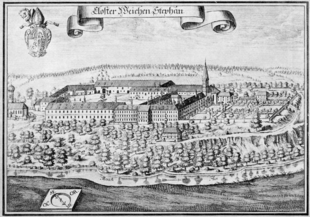Weihenstephan Monastery



The monastery Weihenstephan is a former abbey of Benedictine and former Säkularkanonikerstift in the Diocese of Freising in Freising in Bavaria .
history
The monastery , consecrated first to Sankt Veit , later to Sankt Stephan and Sankt Michael , was founded around the year 830 by the Freising Bishop Hitto von Freising on the " Weihenstephaner Berg".
Around 1020, secular canons (" secular canons ") lived here ; These were transferred by the Freising Bishop Egilbert von Moosburg to the Freising Abbey of Sankt Veit, founded around 833 and then deserted, and replaced by Benedictine monks from the Moosburg Abbey of St. Kastulus .
In the course of secularization in Bavaria , the abbey was dissolved in 1803; In 1810 the abbey church , which was elevated to parish church, was demolished. The Gothic high altar by Jan Polack has been preserved to this day . The eastern and south-eastern parts of the monastery complex were demolished (now part of the courtyard garden). The west wing and south-western part of the monastery building have been preserved to this day, as well as part of the economic building to the west of the monastery. These buildings are now used by the Technical University of Munich. In the south-western monastery wing there is also the ballroom, with stucco work 1705–1710 by Nikolaus Liechtenfurtner . In the courtyard garden, after the archaeological excavations in 1998, the course of the wall of the demolished monastery church was reconstructed, the church is now recognizable as a floor plan again. The garden house in the courtyard garden, the “Salettl”, has also been preserved to this day; the facade was reconstructed in the 1990s. It can now be seen again in its baroque appearance. The "Magdalenenkapelle" from the 18th century, northwest of the former church, has been preserved. The ruins of the former Korbinian chapel, built by the Asam brothers and demolished in 1803, are located south of the courtyard garden on the mountainside.
The buildings and stables, fields and forests of the secularized monastery were sold or transferred to the forest school, which had moved from Munich in the autumn of 1803, and a newly founded "model farm". Max Schönleutner , who also worked as a teacher at the forestry and agricultural school, was entrusted with the management of the former monastery property .
In 1807 the operation of both schools had to be stopped because many students and teachers took part in the campaign of Bavaria, allied with Napoleon Bonaparte , against Prussia and Russia , of which only a few were supposed to return.
In 1852 the agricultural school was relocated again to Weihenstephan and in 1895 elevated to the status of "Academy for Agriculture"; this was the nucleus of today's facilities at the Technical University of Munich and the Weihenstephan-Triesdorf University of Applied Sciences , which form the center of the Freising-Weihenstephan campus .
Abbots
source
- Gerhard I. (1021-1022)
- Arnold (1022-1041)
- Dietfried (1041-1047)
- Henry I (1047-1062)
- Beringer (1062-1064)
- Hagano or Hartwig (1064-1080)
- Henry II (1080-1082)
- Erchanger (1082-1096; first time)
- Pabo (1096-1097; first time)
- Erchanger (1097-1099; second time)
- Pabo (1099–1114; second time)
- Meginhard I. (1116-1138)
- Sigmar (1138-1147)
- Gunther (1147-1156)
- Rapoto (1156-1172)
- Siboto (1172-1174)
- Reginpoto (1174-1182)
- Altun (1182-1197)
- Eberhard I. (1197-1219)
- Meginhard (Meinhard) II. (1219-1224)
- Ulrich I (1224-1226)
- Ulrich II. (1226-1227)
- Ulrich III. (1227–1251)
- Henry III. (1251-1254)
- Ulrich IV. (1254–1256)
- Ludovicus (Ludwig) von Greisbach (1256–1261)
- Conrad I. (1261-1300)
- Conrad II. (1300 – approx. 1311)
- Nicolaus (1311-1312)
- Heinrich IV. Seefeld (1312-131?)
- Walther (131? –1319)
- Conrad III. (1319-1328)
- Conrad IV (1328-1331)
- Marcwardus (Marquard) (1331-1367)
- Seyfrid (1367-1370)
- Gallus (around 1370)
- Albert (around 1370-1374)
- Ulrich IV. Minebeck (Minnerpeck) (1374–1377)
- Sigenhard (1377-1378)
- Administrator : Albertus or Stephan, provost of Neustift (1378–1380)
- Leonhard I (1380-1415)
- Friedrich Preyerl (1415-1416)
- Eberhard II. (1416–1448), received the pontificals in 1430
- Johannes Geisenfelder (1448–1481)
- Leonhard II. Nagel (1481–1484)
- Christoph I. Schleicher (1484–1494; † 1507)
- Wolfgang von Weichs (1494–1495)
- Anton von Wintersberg (1495–1508)
- Benedict I (1508-1520)
- Thomas Karrer (1520–1553)
- Christoph II. Karner (1553–1563)
- Kaspar Fras (1563–1576)
- Paulus Sedlmayr (1576–1579)
- Benedict II. Kiener (1579–1600)
- Sixtus Feichtmayr (1600–1618)
- Christopher III. Eiszepf (1618)
- Georg Tanner (1618–1645)
- Roman Prunner (1645–1649)
- Gregor Marschall (1649–1674)
- Benedict III Rudolph (1674-1705)
- Ildefons Huber (1705–1749)
- Michael Renz (1749–1761)
- Innocent Völkl (1761–1769)
- Gerhard II. Bartl (1769–1803; † 1811)
Individual evidence
- ↑ Äbteverzeichnis (to 1767), according to: Monumenta Boica, Volume 9 (1767), pp 347-350 Google Books . Retrieved May 10, 2011
- ↑ Michael Hartig: Die Oberbayerischen Stifts , Volume I: The Benedictine, Cistercian and Augustinian canons . Publisher vorm. G. J. Manz, Munich 1935, DNB 560552157 , p. 45 f.
- ↑ Alois Angerpointner, Wolfgang von Weichs, Freisinger Canon and Abbot von Weihenstephan, in: Amperland 1965, Issue 1, pp. 032-035, 050-051
See also
- Bavarian State Brewery Weihenstephan
- Weihenstephan Science Center for Nutrition, Land Use and Environment of the Technical University of Munich (WZW)
- Weihenstephan-Triesdorf University of Applied Sciences
literature
- Directory of Abbots (until 1767) In: Monumenta Boica Volume IX, 1767, pp. 347-350 ( Google Books, PDF file ).
- Alois Angerpointner: Wolfgang von Weichs, Freising Canon and Abbot of Weihenstephan In: Amperland , Volume 1, 1965, pp. 32–35, pp. 50–51.
Web links
-
Weihenstephan Monastery , basic data and history:
Christian Lankes: Weihenstephan - nutrient and teaching mountain in the database of monasteries in Bavaria in the House of Bavarian History
Coordinates: 48 ° 23 ′ 42.5 " N , 11 ° 43 ′ 42" E
